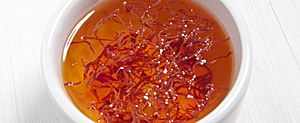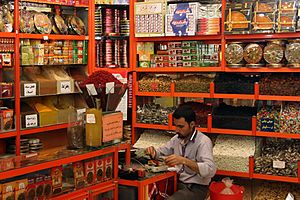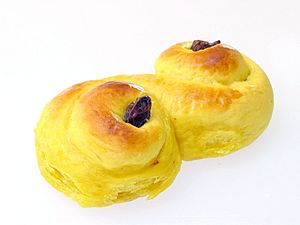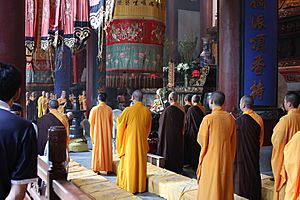Use of saffron facts for kids
Saffron is a very special spice that has been used for over 3,000 years! People use it for cooking, making things smell nice, coloring fabrics, and even in old medicines. It's one of the most expensive spices in the world.
Saffron comes from a beautiful flower called the Crocus sativus, also known as the saffron crocus. We use tiny parts of the flower called stigmas, which are like little threads. These threads are carefully picked by hand and then dried. Dried saffron threads have a slightly bitter taste, a smell like hay, and a hint of metal.
The saffron crocus doesn't grow wild in nature. It's believed to have come from a similar flower, Crocus cartwrightianus, which grew in Crete or Central Asia. The saffron crocus itself first grew in Southwest Asia, and people started farming it in what is now Greece.
For thousands of years, saffron has been used in many ways. People in Africa, Asia, Europe, and the Americas have always loved its bright red threads. They use it in baking, tasty curries, and even drinks. Saffron also colored clothes and other items. Sometimes, it even showed how important or rich someone was! Long ago, people thought saffron could help with many sicknesses, from tummy aches to serious diseases.
Today, most saffron is grown in a large area of Asia and Europe, from the Mediterranean Sea to India and China. The main countries that have always grown saffron, like Iran, Spain, India, and Greece, still produce most of the world's supply. In recent years, Iran has grown about 90-93% of all saffron, making it the biggest seller.
Farmers in Pennsylvania, USA, started growing saffron in the Americas. More recently, it has also begun to be grown in New Zealand, Tasmania, and California.
Cooking with Saffron
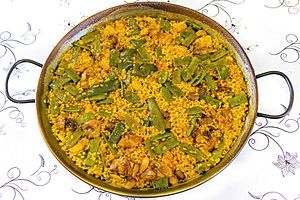
Saffron is used in many dishes from Europe, North Africa, and Asia. Experts say its smell is like honey, with hints of wood, hay, and earth. Some describe its taste as hay-like, but with a bitter touch.
Because saffron gives food a bright yellow-orange color, it's used all over the world. You can find it in cheeses, candies, drinks, baked goods, curries, meat dishes, and soups. Long ago, some rich people used a lot of saffron in their food, not just for taste, but to show off how wealthy they were!
In Kashmir, a region in India, saffron is used to make kehva. This is a fragrant drink made with saffron, almonds, walnuts, and cardamom. It's also used in special wedding meals called Wazwan. Here, chicken is cooked in a saffron liquid, and the dish is called konge kokur.
Because saffron is so expensive, people sometimes used other spices instead. Safflower (Carthamus tinctorius) or turmeric (Curcuma longa) were often used. Both can make food yellow like saffron, but they taste very different.
Saffron is also used in candies and alcoholic drinks. This is its most common use in Italy. Drinks like Chartreuse, izarra, and strega get their color and flavor from saffron.
Before adding saffron threads to a dish, people often crumble them and soak them in water or sherry for a few minutes. This helps the color and flavor come out into the liquid. If you use powdered saffron, you don't need to do this. The soaking liquid is then added to the hot food. This makes sure the color and flavor spread evenly, which is important for baked goods or thick sauces.
Saffron threads are very popular in rice dishes in Spain, Iran, India, and Pakistan. Two famous examples are zarzuela, a fish and seafood stew, and paella valenciana, a tasty rice and meat dish. Saffron is also essential for making the French bouillabaisse, a spicy fish stew from Marseilles, and the Italian risotto alla milanese.
The saffron bun is a popular treat in Sweden and Cornwall, England. In Sweden, it's called lussekatt (meaning "Lucy cat") or lussebulle. This is a rich bun made with yeast dough, saffron, cinnamon or nutmeg, and currants. People usually eat them during the Christmas season, especially on Saint Lucy's Day. In England, saffron "revel buns" were traditionally baked for special parties or church events. In Cornwall, large saffron "tea treat buns" are a symbol of Methodist Sunday School trips.
In the La Mancha region of Spain, saffron is used in almost every traditional dish.
Moroccans use saffron in many dishes that are both savory and sweet. It's a key part of chermoula, a mix of herbs that flavors many Moroccan foods. Because it's expensive, saffron is mostly used for special occasions or in fancy Moroccan recipes like pastilla. Other Moroccan dishes with saffron include some types of tajines, kefta (meatballs with tomato), mqualli (a chicken dish with citron), and mrouzia (lamb with plums and almonds).
In Uzbekistan, saffron is used in a special rice dish called "wedding plov." Saffron is also a must-have in chelow kabab, which is the national dish of Iran.
In South Indian cooking, saffron is famously used in Kesari bhath, a sweet dessert made from semolina. South Asian foods also use saffron in biryanis, which are spicy rice and vegetable dishes. An example is the Pakki version of Hyderabadi biryani. Saffron spices beef and chicken dishes and goes into many sweets, especially in Muslim and Rajasthani foods. Today, you can even find saffron ice cream! Regional milk-based sweets also feature it, such as gulab jamun, kulfi, double ka meetha, and "saffron lassi." The last one is a sweet yogurt drink from Jodhpur, India, that has a special cultural meaning.
Saffron as a Dye
Even though saffron is expensive, it has been used to dye fabrics, especially in China and India. However, the bright orange-yellow color it gives fabrics fades quickly to a pale yellow. Even a tiny amount of saffron can make a bright yellow-orange. If you use more saffron, the fabric will become a richer red color.
Clothes dyed with saffron were traditionally worn by important people, like nobles. This showed that saffron played a role in rituals and in showing someone's high status. It was originally used to color the red, orange, and saffron-colored robes worn by Buddhist and Hindu monks. In medieval Ireland and Scotland, wealthy monks wore a long linen undershirt called a léine, which was traditionally dyed with saffron.
In science, saffron is used in special stains for looking at tiny parts of living things under a microscope. For example, it helps make collagen (a type of protein) look yellow.
Many attempts have been made to find a cheaper dye to replace saffron. The usual substitutes in food, like turmeric and safflower, make a very bright yellow that looks quite different from saffron's color. The main coloring part of saffron is called crocin. Scientists have found crocin in the gardenia fruit, which is much easier and cheaper to harvest. Research is still ongoing in China to find good alternatives.
Saffron in Perfumes
In Europe, saffron threads were a key part of a fragrant oil called crocinum. This oil contained many different ingredients, like alkanet, dragon's blood (for color), and wine (also for color). Crocinum was used as a perfume for hair.
Another way saffron was used was by mixing it with wine to create a thick yellow spray. This spray was used a lot in sunny Roman amphitheaters, like a giant air freshener!


